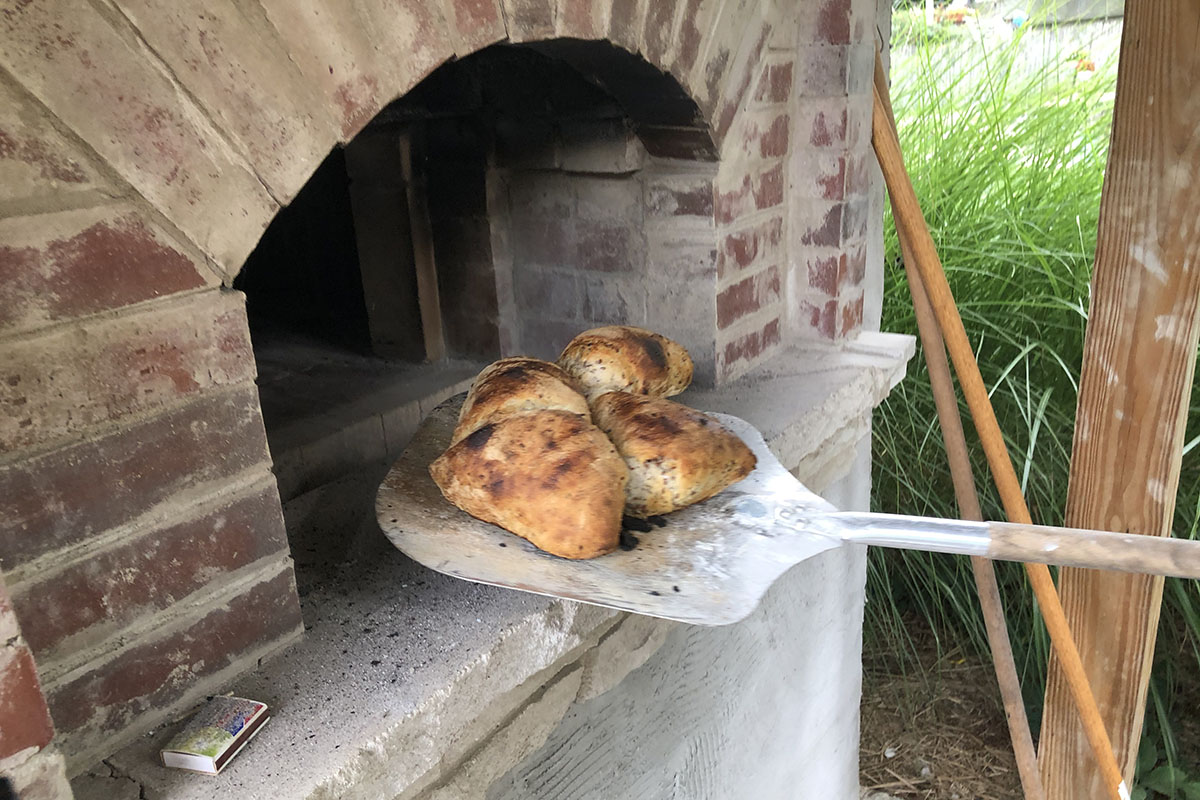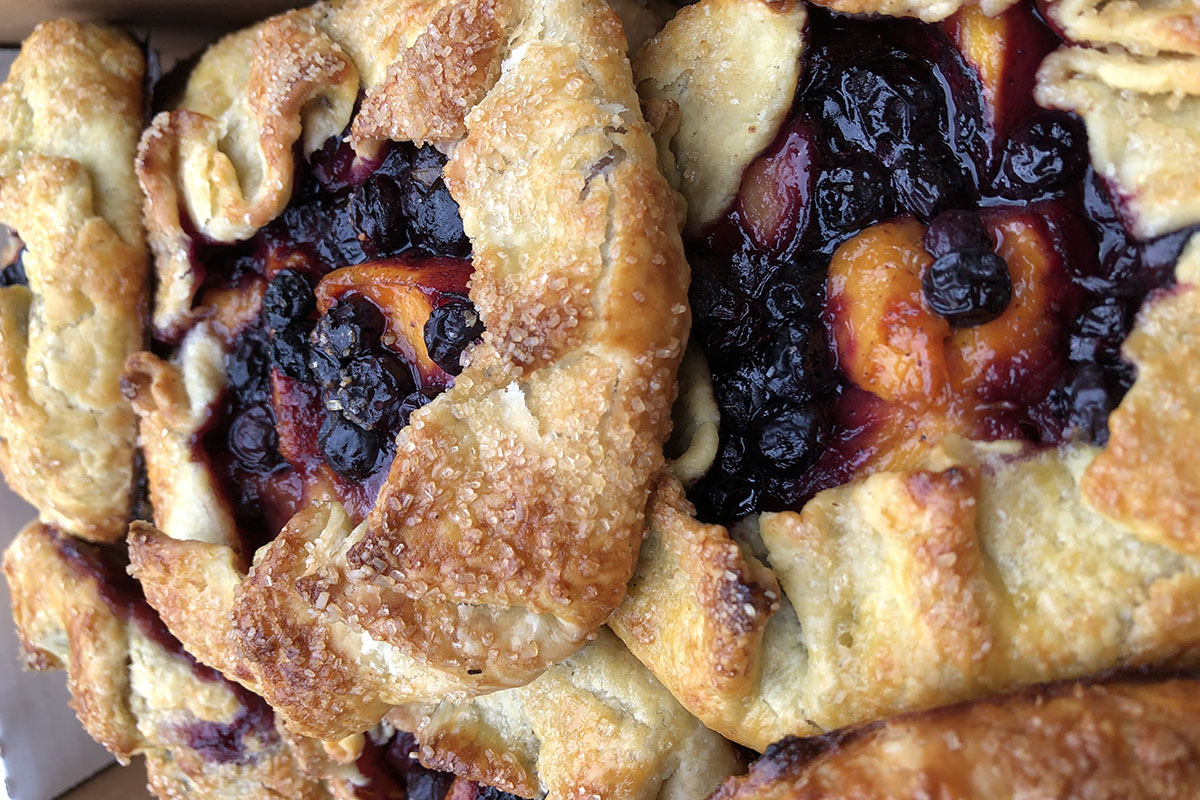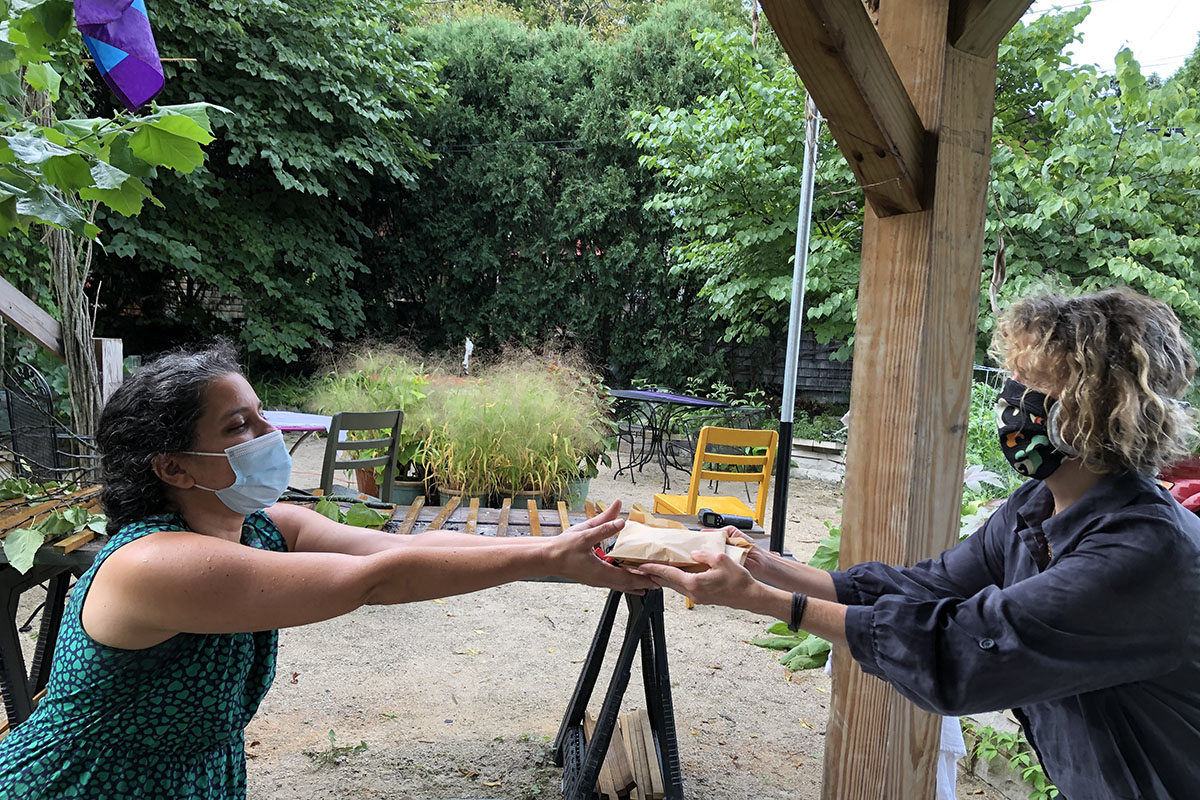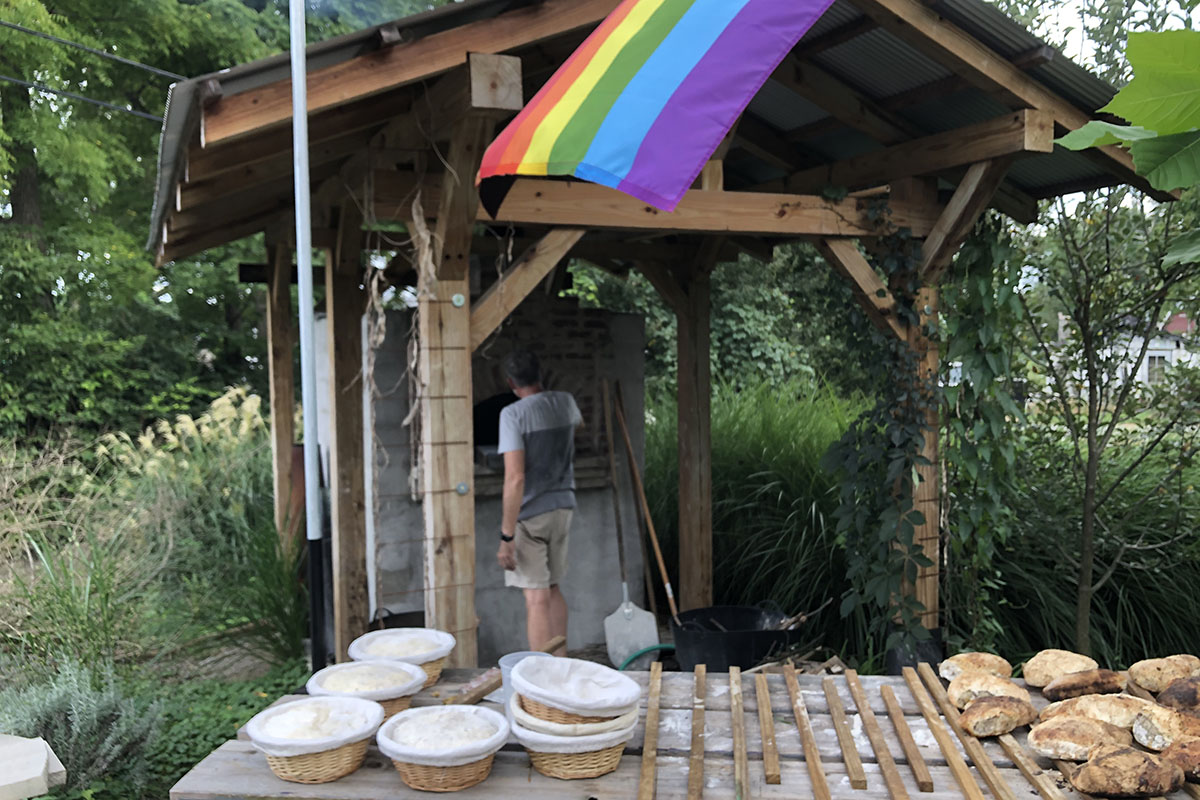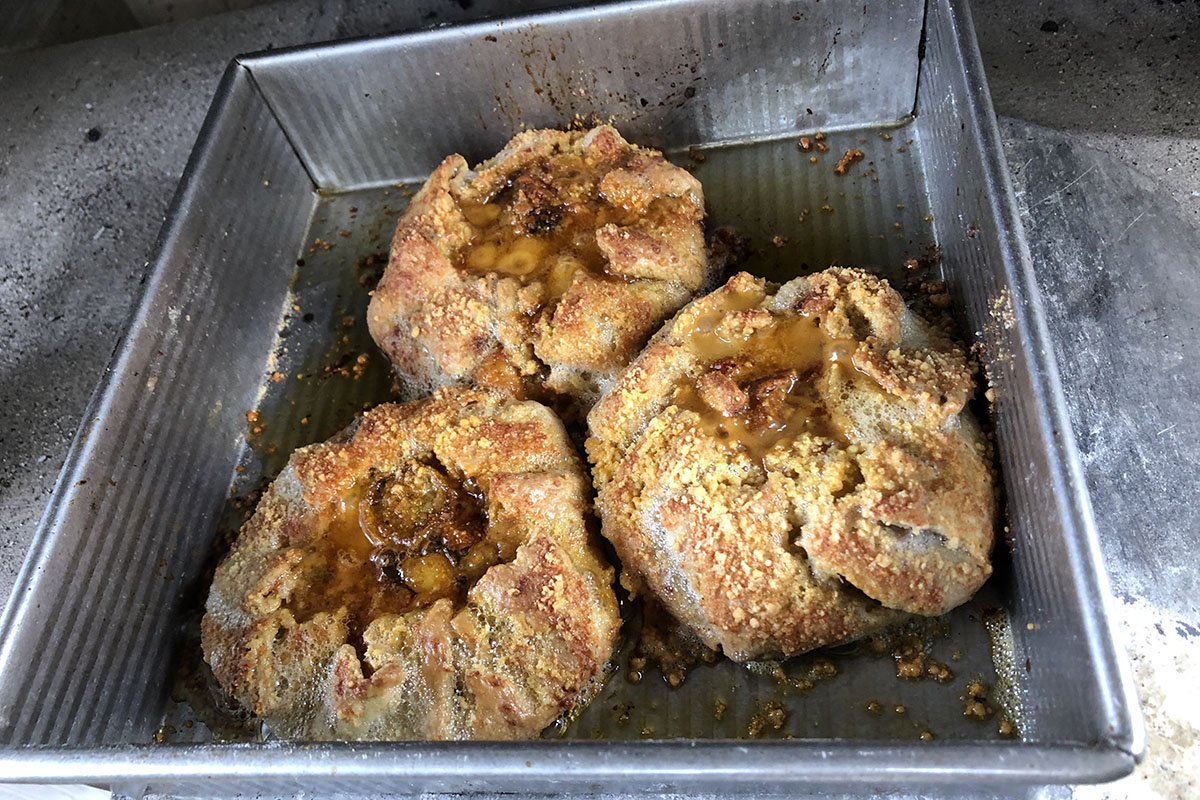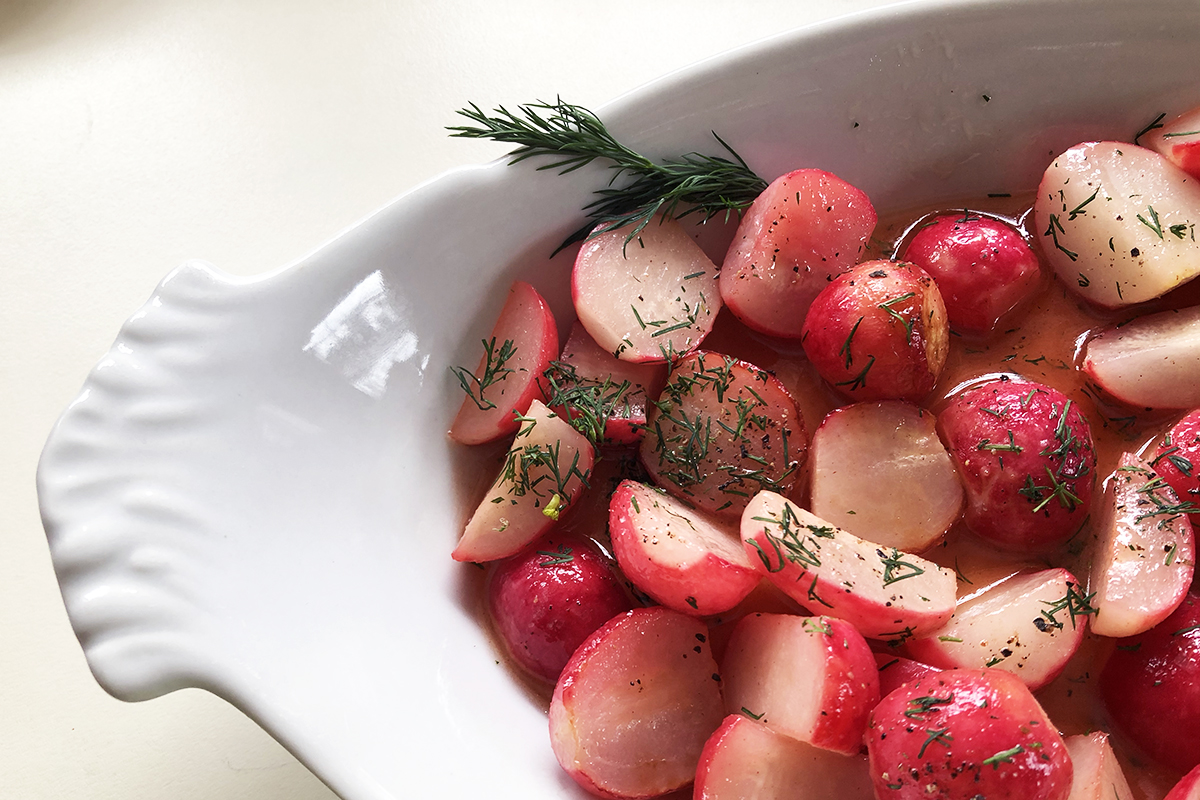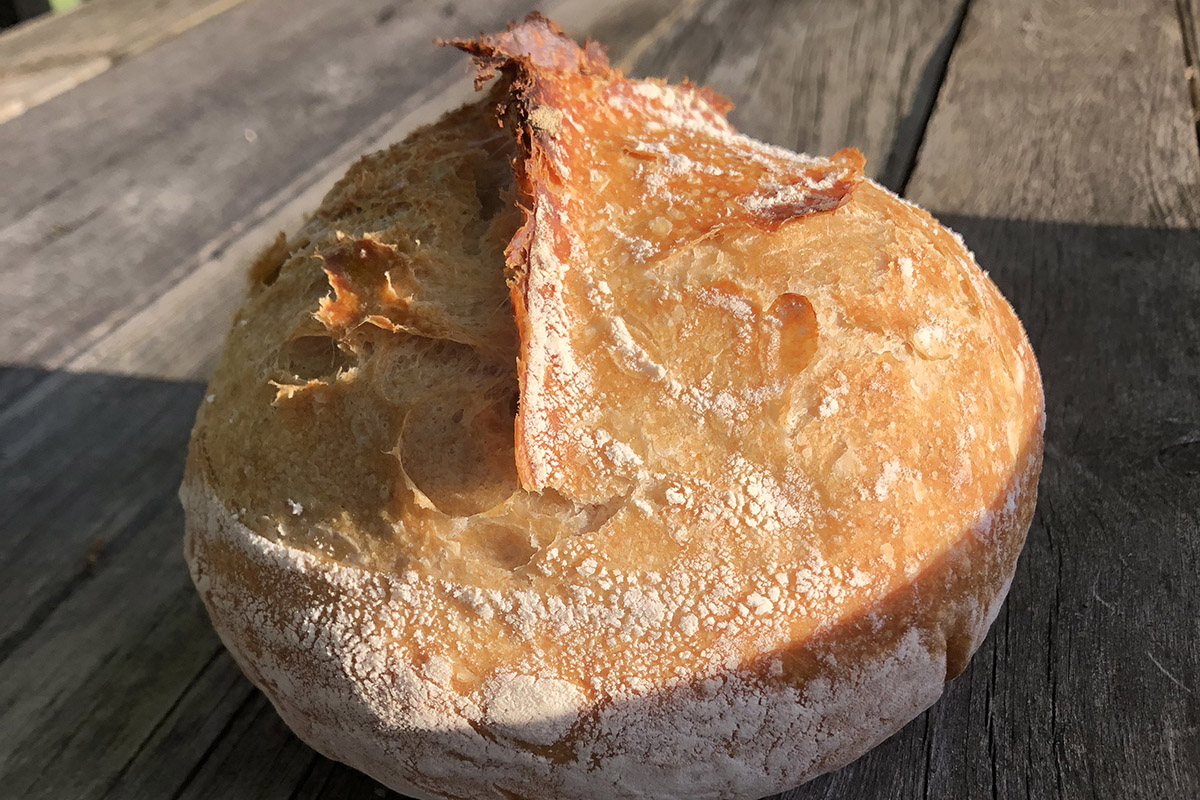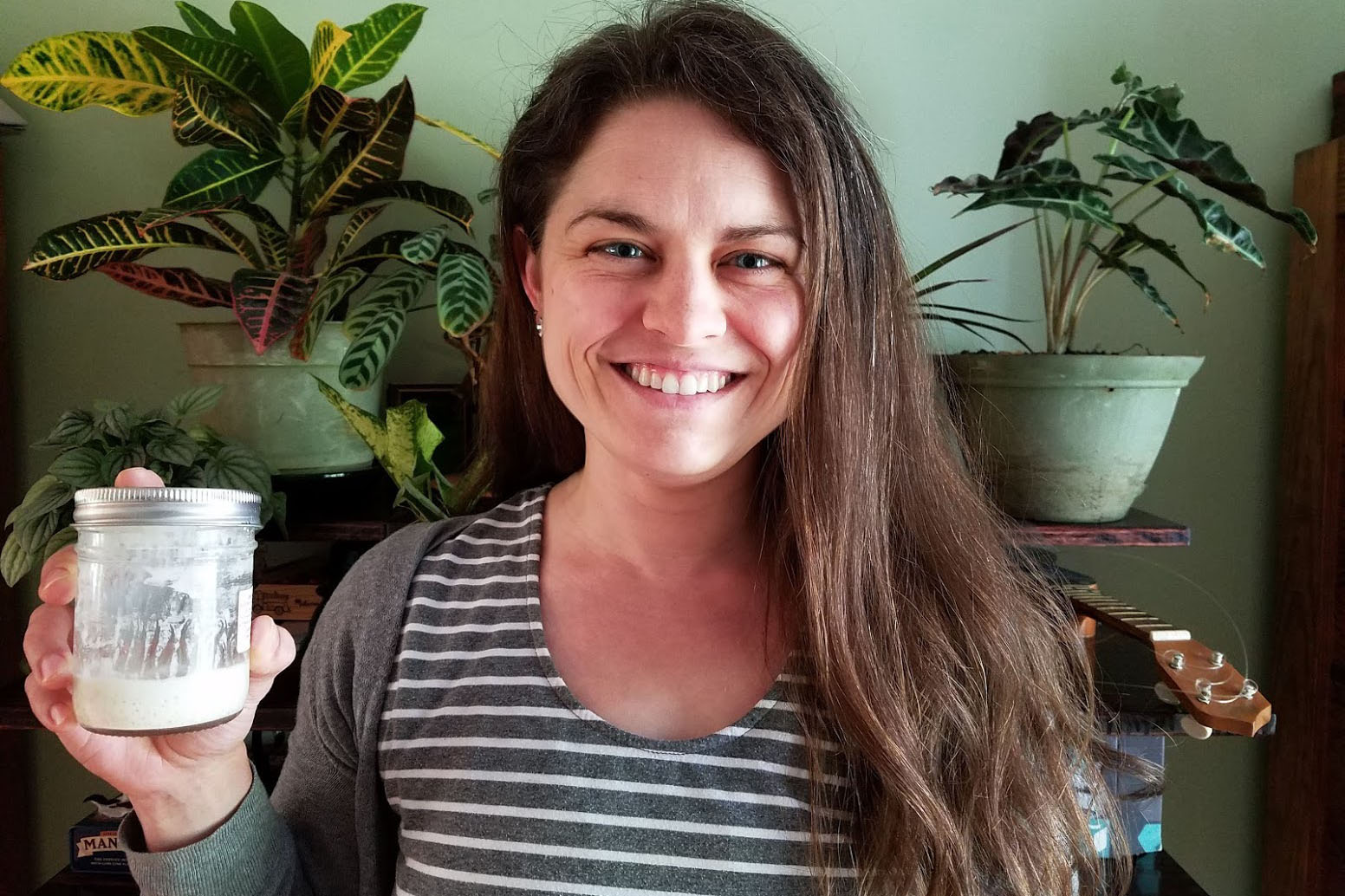KAYTE YOUNG: From WFIU in Bloomington Indiana, I'm Kayte Young and this is Earth Eats.
KEITH ROMAINE: I've found that making smaller loaves is better, so they're little guys. They look like little animals when they get done.
KAYTE YOUNG: This week on our show we visit a backyard brick oven and talk with Keith Romaine and Amy Roche about their neighborhood pop-up bakery. And we have two more stories about sourdough, a spring recipe featuring radishes, plus Harvest Public Media reveals a mystery about grasshoppers. All that just ahead, so stay with us.
RENEE REED: Earth Eats is produced from the campus of Indiana University in Bloomington Indiana. We wish to acknowledge and honor the indigenous communities native to this region, and recognize that Indiana University is built on indigenous homelands and resources. We recognize the Miami, Delaware, Potawatomi, and Shawnee people as past, present, and future caretakers of this land.
(Music)
KAYTE YOUNG: I'm Kayte Young, welcome to Earth Eats. We're starting off with a recipe for one of the first vegetables from the spring garden - radishes. Radishes are some things that I really love to grow. They're one of the first things to come out of the ground in the spring. They are gorgeous to look at. They're just so bright and cheery and bursting with flavor, sometimes a little too much flavor, depends on what you like.
But the problem with radishes is that they're often all ready at once. And so I've got a ton of radishes in my kitchen that are ready to eat right now, and they're fresh and I don't quite know what to do with all of them. There's only so many radish sandwiches you can eat. Of course they're great on a salad just sliced in and put on top of your fresh salad greens. But I'm always looking for something else to do with radishes, and I found something.
This preparation is really simple, and you cook them a little bit. Which may sound sort of strange, you don't usually think of radishes as being cooked. This one is really simple, and it uses a lot of radishes.
So you want between 12 and 20 radishes to start with and depending on their size you're going to cut them up either in half or in quarters depending on how big they are and what you prefer. And then the next step is to melt some butter in a pan.
(Sound of gas stove clicking and lighting)
Let the pan warm up a little bit and then add your butter. We're going to add 3 tablespoons of butter to the pan.
(Sound of butter sizzling quietly in pan)
Once that butter is nice and sizzling just add the radishes. Stir to coat.
(Sound of radishes being gently stirred in pan)
And then reduce the heat a little bit and put a lid on it and cook for about 5 minutes. You don't need to stir constantly but just occasionally shake the pan to keep them from browning on one side.
(Cheerful music)
(Microwave alarm beeping)
So there's our timer let's check and see how these radishes are looking. They are gorgeous. They're beginning to get tender. And now we're going to add 2 teaspoons of sugar to pan. And next we're going to add 1 tablespoon of red wine vinegar.
Just going to stir and cook that for a couple of minutes. Gonna let that develop into a bit of a sauce. And we'll turn off the heat, and they're just beautiful. They seem to have brightened up. I think if we cooked them a little bit longer they might begin to lose a little bit of that color but right now they're still nice and bright.
And then we're just going to transfer that from the pan to a serving platter. And then we're going to sprinkle generously with salt.
(Sound of salt gently shaking)
A few turns of black pepper.
(Sound of a wooden spice grinder)
And some finely chopped dill. And that's it our butter braised radishes with fresh dill.
Let's give it a taste. That's really nice. The cooking really takes away some of the bite of the radish, but you still get that nice earthy flavor, and the dill is a perfect compliment. It's bright, it's tasty, it's fresh, and it's a great way to serve radishes and so fast it comes together in like 5 minutes. It's a great way to prepare your radishes if your garden is giving you a bounty this spring. Enjoy.
Find this recipe and more spring favorites at Earth Eats.org.
Our next story first aired in the fall of 2020.
(Relaxing banjo transition music)
KEITH ROMAINE: So I was said, "Oh, okay. Well I’ll just make woodfired bread oven in the backyard." Couldn't be that hard.
KAYTE YOUNG: When Keith Romaine dreamed of building a brick oven in his backyard almost 7 years ago, he was picturing neighborhood gatherings and festive evenings featuring hot pizzas, steamy loaves of fresh baked bread, and bottles of wine and cold sparkling water passed across tables. In other words, he wasn't picturing life in a global pandemic. But now that his wood fired brick oven is finished, and his backyard has been transformed into a lovely garden piazza, he's finally ready to start baking bread and sharing it with his community. He and a friend have recently started a pop-up bake sale on Friday evenings in Bloomington Indiana. I paid a visit to Keith's place, which is just a few blocks away from my house.
(Sound of gravel crunching underfoot. Forest sounds; insects chirping)
Keith's house is nestled in a shady almost wooded magical looking alley. His yard is filled with trees and vines and lush ground cover, and this lovely front porch. He's got a kind of a gnarled and twisted beautiful old redbud in the front. And as you go down this alley it's like you enter a microclimate. The temperature drops like 10 degrees, so it’s a very secluded feeling, kind of tucked away.
And Keith pays a lot of attention to aesthetics. He's an artist and he has created an oasis here in McDoell Gardens Neighborhood. He has a lovely patio space that he has designed and built with stone walls and edible garden beds and climbing flowers. It’s really a gorgeous space.
He refers to it as the piazza, complete with a gurgling fountain in the center surrounded by feathery plants. I stopped by in the late morning when Keith was just getting the fire started.
KEITH ROMAINE: Just to build a good fire and then this maybe obvious but newspaper and paper, wad it up, and then add little twigs, little guys. These are just things that are left over from my yard honeysuckle.
(Sound of a match being struck)
So the goal is to keep building it up and building up until it's a basically a roaring fire. And the inside of the oven will get up to around 700-750. You wanna use wood that burns hot and fast.
KAYTE YOUNG: Do you have any kind of dampers or louvers or anything like that?
KEITH ROMAINE: Nope it just goes straight up. It's not like a regular fireplace that has the chimney right above the fire. When it's sealed off with the bread in it is to completely airtight, allowing steam to build up.
KAYTE YOUNG: Okay so having a chimney right inside of the chamber wouldn't really work.
KEITH ROMAINE: Yeah that's the reason why regular home ovens don't work, because they let air in and out.
KAYTE YOUNG: [Narrating] By "don't work", Keith means you can't get that crusty bake with full ovens bring very easily on your home baked bread in part because home ovens usually don't get hot enough, and also because they don't trap steam as well as a brick oven like his does.
KEITH ROMAINE: The fire's going good now.
(Sound of fire crackling)
And I'll just keep building the fire for the next... five hours I'm going to keep building it. This is called a black oven, it's an oven where you build the fire inside the chamber where the bread is going to be. And the oven is built so that it has very thick masonry walls, first with fire brick that's closest to the fire, and then on top of that is quite a lot of concrete and then on top of that is vermiculite insulation to hold the heat in.
KAYTE YOUNG: So you're heating up the interior space and those bricks and they're holding that heat...
KEITH ROMAINE: Yes.
KAYTE YOUNG: Throughout the baking process.
KEITH ROMAINE: Mhm, exactly. How that works is that I get the oven heated up and then I pull out all of the ashes and swab it out with a towel, it'll be wet. So then it'll be about 700 degrees, and I put in the first batch of about 16 loaves. And I've found that making smaller loaves is better, because when you have a really hot oven it's too hot to cook all the way through if the loaves are big. So they're little guys, they look like little animals when they get done, they're cute.
KAYTE YOUNG: [Narrating] What Keith means by "too hot to cook all the way through" is that the outside of the bread might get too crispy or even burnt before the interior has a chance to fully bake. So for now he's sticking with smaller loaves. We'll return to Keith's brick oven later in the show for bread baking and a neighborhood popup bake sale.
(Relaxing banjo music)
(Transition music)
(Transition music featuring slow banjo strumming and hand drums)
We're back with Keith Romaine and his wood fired brick oven in his backyard piazza. He's been stoking the fire and heating the oven for more than five hours now, and he's already put the first batch of bread loaves into the oven. While they bake, he sets up his makeshift cooling rack on the redwood plank table in front of the stove.
KEITH ROMAINE: These are not special bread boards. They're two by fours that have been ripped.
KAYTE YOUNG: The cooling rack consists of thin strips of wood arranged about four inches apart across one third of the table.
KEITH ROMAINE: It works, because they need to breathe a little bit, if they don't the bottoms get all soggy.
KAYTE YOUNG: So what kind of bread is this? I'm seeing a lot of seeds.
KEITH ROMAINE: It's a sourdough, and it's all organic, whole wheat flour, all-purpose flour, and bread flour, and then it has chia seeds and flax seeds in it. And those aren't just for nutrition, but they make the bread... one of the things that I love about bread when it's really yummy to me is this that it's almost... it melts in your mouth on the inside and it's lightly crispy on the outside, as opposed to being dry on the inside. I'm not a fan of that kind of bread anymore.
They describe it, bread people, as pudding. But it's not, it's cooked. It rises and it can cut like slices, so it's not like gooey. The other thing about this kind of bread is that it lasts for about five days as opposed to regular sourdough, by the time the next day comes it's already... now it's a day old.
I just put it in, and you saw I just closed it. But I should check it.
KAYTE YOUNG: Okay.
KEITH ROMAINE: Because it's hot in there.
KAYTE YOUNG: [Narrating] It was time to check on the first batch of bread in the oven.
(Sound of metal scraping over brick)
KAYTE YOUNG: Oh wow, those definitely got their oven spring, didn't they?
KEITH ROMAINE: They did! And it's so amazing.
KAYTE YOUNG: Once the loaves are out, Keith turns to the dough, resting lemon lined baskets on the other two thirds of the table. He flours the long-handled paddle shaped metal peel and turns the dough ball onto it.
KEITH ROMAINE: And I what I do with these loaves, these are about two pounds. So I cut them into four and then stick the... I stretch them a little bit but mostly I don't do too much to them because they don't need it. They just grow in the oven.
KAYTE YOUNG: Okay.
KEITH ROMAINE: In their own little funny shapes.
KAYTE YOUNG: [Narrating] He quickly slides the loaves into the back of the oven and prepares three more rounds for a total of 16 loaves per batch. Once the loaves are inside, he fits the thick metal door over the oven's entrance and notes the time.
KEITH ROMAINE: These are really beautiful; I like that they're not all exactly the same. What's interesting is that I'm a fiber artist and when I was in graduate school I would make things that looked kind of like this. I had no idea that I was getting ready to make bread.
KAYTE YOUNG: You mean that looked like the finished loaves?
KEITH ROMAINE: Yeah. They're...
KAYTE YOUNG: [Narrating] I asked Keith about the backstory to his wood fired brick oven.
KEITH ROMAINE: So about 10 or 15 years ago I start having dinner parties at my house. And then I went to Italy and discovered that there was better bread in some places of the world then there is in Bloomington.
So I said, "Oh okay, well I'll just make a wood fired bread oven in the backyard" Couldn't be that hard.
So I planned it and thought about it, and dreamed about it, and read lots of micro bakery success stories. With a group of people we created a Kickstarter campaign.
KAYTE YOUNG: [Narrating] They raised around $8,000, $3,000 of that came from Keith himself, but the project ended up being much more involved than they anticipated, as projects often are. The total cost was closer to $20,000 and it took nearly seven years to complete.
KEITH ROMAINE: I needed a way to get from the kitchen to the oven... it was a 10-foot drop. I built stairs, built a porch...
KAYTE YOUNG: [Narrating] And he built the piazza which required some earthwork, and the building of stonewalls and garden beds in addition to the oven itself and a roof to cover the brick oven and the workspace in front of it.
[Interviewing] So the vision wasn't just to make bread for yourself, you had a larger...
KEITH ROMAINE: It was, it was a community building. Bread traditionally is something... "to break bread together" is an old, very old saying of people coming together. But I'm going to check this bread.
KAYTE YOUNG: Okay.
[Narrating] The last of the bread is out of the oven, and before too long his friend Amy has arrived and they're getting ready for the popup bake sale. Amy Roche is Keith's friend, neighbor and a baker herself. She bakes part time at Two Sticks Bakery and in own kitchen, pies are her specialty.
AMY ROCHE: I have to mark people off when they purchased. I'm the keeper tracker.
KAYTE YOUNG: [Narrating] Together with Keith they've started a Friday night popup bake sale.
AMY ROCHE: Yeah, I'm taking preorders, I've got a list of people that I started with, people I know who are interested in local seasonal food. And then word of mouth from there, and we've been... yeah selling out in preorders, all that we can kind of do in a day.
KAYTE YOUNG: [Narrating] And so far, the menu is simple.
AMY ROCHE: Three things, a mini sourdough like crusty rustic sourdough, seeded loaf of bread, from Keith, and a sweet and savory gallate - seasonal. So the flavor is based on what I can get my hands on that week.
KAYTE YOUNG: And you've been doing it for four weeks?
AMY ROCHE: Yes, just adjusting along the way with what works for us and for customers... and we haven't had to adjust that much, it's been going well.
KAYTE YOUNG: [Narrating] Amy and Keith are still working out temperatures and timing with baking the galettes in the brick oven. On this day, Amy slides of her two savory tomato and cheese galettes into the brick oven for a trial.
AMY ROCHE: Local eggplant, sauteed with olive oil and garlic, and there's local organic mozzarella.
KEITH ROMAINE: It's very hot.
AMY ROCHE: Okay. Tossed in smoked paprika, some heirloom tomatoes...
KAYTE YOUNG: And then they're wrapped in a pie dough.
AMY ROCHE: They're wrapped in... yeah, a pie dough that it has organic butter and local eggs in it. Then I sprinkled a little pecorino romano on top because I love pecorino romano.
KAYTE YOUNG: Yeah (chuckles).
AMY ROCHE: Yeah you can...
KAYTE YOUNG: [Narrating] When Keith pulls out Amy's tarts the tomato filling is bubbling like hot lava and the aroma penetrates even the thickest face covering.
(Kayte Young, Keith Romaine, and Amy Roche chatting indistinctly in the background
[Narrating] Customers arrived for pickup in a steady stream throughout the hour. Everyone wore face masks, and it was easy to maintain a safe distance on the piazza.
(Amy Roche chatting in the background with customers)
A cool summer shower sent the bakers under the brick oven's porch for the remainder of the sale, and Keith and Amy basked in the warmth radiating from the brick oven and the joy of sharing the creations with friends and neighbors.
(Sound of rain pattering on the piazza)
CUSTOMER: Oh my god Keith this is beautiful, thank you so much.
AMY ROCHE: Love you guys, take care.
KEITH ROMAINE: Thank you!
KAYTE YOUNG: Visit our website for photos of Keith Romaine's backyard woodfired brick oven, his adorable loaves of sourdough, and Amy Roche’s stunning seasonal galettes. EarthEats.org is the place to go.
This story is from September of 2020. The backyard bakery stand, known as Stonewall Bakery continues. Check out our website for an update from Amy and Keith.
(Calm banjo transition music plays out)
The Konza Prairie has seen a dramatic drop in grasshoppers over the last quarter-century, even where the grasses they feed on thrive. The problem reports Brian Grimmett of the Kansas new service comes from changes in that grass, and what that means for the rest of the food chain.
BRIAN GRIMMETT: The long-term ecological research program on the Konza Prairie near Manhattan Kansas has been watching the grass grow, really watching it grow, for 40 years. That's given scientists one of the most comprehensive studies of grassland ecology in the world. Which made it a perfect laboratory for postdoctoral researcher Ellen Welti when she wanted to figure out the ebbs and flows of grasshopper populations. You know, the kind of topic only a hardcore bug scientist would love.
ELLEN WELTI: We thought that this is a pretty nice habitat for grasshoppers. It's doesn't have a lot of the pressures we usually associate with insect decline, like there's no pesticide spraying, the size of the habitat isn't shrinking. It's this big natural reserve.
BRIAN GRIMMETT: But her research team found something odd - grasshopper populations had declined steadily - about 2% every year for the past 25 years. Michael Kaspari is a research professor at the University of Oklahoma and was an advisor for Welti's paper.
MICHAEL KASPARI: And it's like compound interest, you add that up over 25 years and we're talking about a significant decline, and again, one of the most important insects of the prairie.
BRIAN GRIMMETT: That big of a decline surprised both of them. Grasshoppers should have been doing great on the all-natural undisturbed prairie where they were looking. So why weren't they? Welti began by looking at their food, even an ordinary sized population of grasshoppers consumes as much grass on a pasture as your typical heard of Kansas cattle. Luckily for her the Konza research site at Kansas State University doesn't just track grasshoppers, it's also taken tens of thousands of samples of grass every year for 40 years.
AMANDA KUHL: It starts with a paper bag like that. And inside that paper bag is some grass material, and then there's probably other paper bags inside.
BRIAN GRIMMETT: That's Amanda Kulh, she's a research assistant at the Konza research site. She's in charge of collecting and cataloging the samples. It's a massive project. Paper bags full of samples line walls clear to the ceiling.
AMANDA KUHL: Yeah so once they get these cleaned up they'll go back into a drying oven to remove all the moisture, I'll weigh them, and that's how we get our biomass numbers.
BRIAN GRIMMETT: Which turned out to be key. When Welti they looked at those numbers over the years the grass was actually getting bigger.
ELLEN WELTI: At first it looks like there is overall more food availability for grasshoppers but when we got back the plant chemistry what we could see is this increase in plant biomass really corresponded to decreases in the quality of the biomass.
BRIAN GRIMMETT: It's something called nutrient dilution. Think grasshopper junk food. There's less nutrition per bite. Kaspari says it happens because increased carbon dioxide in the atmosphere from burning fossil fuels makes the plants bigger, while the nutrients in the soil such as nitrogen, potassium, and sodium aren't really changing. He says it's like switching a plate of kale for a plate of iceberg lettuce. Both plates might have the same amount, but one has a lot more of the good stuff bodies need.
MICHAEL KASPARI: Every bite of those grasses is giving less and less back to all the other organisms, all the other living things that depend on the plants.
BRIAN GRIMMETT: Welti says it's clear that where there's nutrient dilution, grasshoppers don't prosper.
ELLEN WELTI: And even year-to-year variation in low grasshopper years matched up with when the plant biomass was high but also the nutritional quality of the plants was low.
BRIAN GRIMMETT: She says fewer grasshoppers will lead to fewer birds. Fewer birds could mean more rodents. Declines in one species of grasshopper could also lead to more of another species leading to swarms that could threaten crops.
And the problems only ripple out from there. She says nutrient dilution which she says is the underlining problem is that for all plant-eaters, from grasshoppers and leaf beetles up to bison, and cows, and ultimately us.
For Harvest Public Media I'm Brian Grimmett.
KAYTE YOUNG: Find more from this reporting collective at HarvestPublicMedia.org.
(Cheerful transition music)
We didn't manage to get Keith Romaine's bread recipe, but I thought it might be a good time to share the sourdough recipe I always use. I have shared it here before but it's multistepped and some of you might want a refresher.
I learned how to make sourdough from Alex Chambers. Alex has been a producer on our show you might remember him. He's really good at making bread. He's really good at teaching too. If you don't have an Alex Chambers in your life there are a lot of great bread tutorials out there right now, YouTube videos, Instagram. When it comes to bread making though there's no substitute for experience. You just got to get in there and make some bread. If you can't handle failure this might not be the hobby for you, you will fail. But usually the failures are edible. Butter on freshly baked bread is almost always tasty and you'll learn from those less-than-perfect loaves. Trying and failing is the only way to find out what works, what doesn't what, fits with your schedule and your lifestyle and also what kind of bread like I prefer what's known as a lien bread rustic and crusty. My bread has three ingredients flour, water, and salt. Okay, for if you count the starter and it's made from flour and water and wild yeast gathered from the environment. Here is my step by step we're going to assume that you already have a starter, if you don't not to worry, I'll post instructions for how to make one. It's not difficult, it just takes time. I started with one of the things I love most about this method.
The starter is tiny, it's a tablespoon. You can keep it in your fridge without doing anything for about two weeks, that's what's recommended, but I can tell you that I have left mine in my fridge for months and taken it out, and it's fine. So I'm gonna do that right now.
And I keep it in a small jar, like a little jelly jar. It smells... (sniffs) it smells really yeasty, it's acidic I think is a word I would use. Sometimes I feel like it smells a tiny bit like glue, like Elmer's glue. Not so much this time.
It smells pretty good and now I'm just gonna add a tablespoon of whole wheat flour, a tablespoon of white flour, and a tablespoon of water. And then you just want to mix it up really good, and I just leave it in the jar for this stage. And then to cover it I have one of these like really small shower cap type things that you can put over bowls like these old fashion bowl covers, looks like a little shower cap. If you don't have one of those you can just use some saran wrap or even probably just put a towel over it, it'd be fine.
I'm gonna leave it out for a few hours, I'm gonna check on it and see how it's doing.
(Playful piano music)
(Timer ringing)
Okay so it's time to check on our starter. I'll admit it has been more than two hours. But that's fine, this is a very flexible process. I've taken off the little shower cap. (Sniffs) It's always good to smell it. The other thing I'm doing is I'm looking at the jar and I'm seeing air bubbles on the side.
And I'm gonna take a spoon and kind of... I think you can kind of hear those air bubbles in there and that means it's alive. So it's doing its thing, it's growing. Now we officially have a starter, I basically built a starter by adding a little bit more flour and water to it, feeding it.
So now I have a starter and I can make the next stage which is called the leaven. And that requires half a cup of whole wheat flour, half of cup of white flour and half a cup of water, plus this starter.
So I scraped all of that starter out of the jar and I'm putting it into the bowl with the water, and then half a cup of whole wheat flour and half a cup of white flour.
I'm just gonna mix it up really well in a medium sized bowl, and once again I'm gonna cover it. And we're gonna let this sit out for a few more hours.
(Playful piano music)
(Timer ringing)
Okay we are back with our sourdough and we're at the stage of the leaven. We want to see if it has sufficiently fermented. So the way I'm gonna test this is I’m just gonna pull back on the bottom of the dough in the bowl. If you're seeing lots of air bubbles and it's starting to look kind of loose and webby on the bottom then that means your dough is alive, it is fermenting, and you're probably ready to move on to the next step.
The first thing you wanna do with this leaven is you wanna take a tablespoon of it out, and you want to put it in your starter jar and stick it back in your fridge. Now you are ready to make your dough.
Take your leaven that you've let rise, start by adding about a cup of the water to the bowl that the leaven is in. Just want to mix that in really good until it's nice and soupy. And you're gonna mix your dry ingredients in a large bowl. You can do whatever mix you want, I like to do about 5 cups of white bread flour, and one cup of whole grain flour. Sometimes I'll do half and half, very flexible. And I have some special flour, whole grain flour that I got from Muddy Fork Bakery, and they got it from Jaime's Mill. This is stone ground, high protein, whole grain flour. I think this particular whole grain flour has been shifted to extract some of the bran, so it's gonna be a little bit lighter than your typical whole grain flour. I'm excited to try it.
So you got your six cups of flour, one tablespoon of salt, and then the leaven that you've mixed with the water, and then two more cups of water. You're gonna mix all that into one bowl. And that is gonna be your big shaggy mass as Alex calls it. And that's gonna be your dough. And it's not gonna look like a shapeable bread dough. At this point it's just gonna be a wet shaggy mass, and that's fine.
Once it's thoroughly mixed you're gonna cover it with some plastic wrap, or a damp cloth and we're gonna let it rise some more. You're gonna want to set a timer, every half hour, every 45 minutes, you're gonna wanna fold this dough. Which basically just means pulling up a corner and folding it over and spinning a quarter turn, pulling it up, folding it over, spinning it a quarter turn, and doing that four times. And then cover it back up and leaving it and setting another timer. You want to keep doing this, you don't want to forget, so set a timer.
(Playful piano music)
(Timer rings)
And then when you are ready for your final proof, you want to dust your surface, a surface in front of you on your countertop with some flour. And then dump your dough out onto that surface. And you want to divide your dough in half. This recipe makes two loaves. And again you're just gonna want to do some folding to shape it.
Shaping is hard to explain. Press your dough out and then pull at the edge, the edge furthest away from you and fold it into your dough. And then pull up the edge closest to you, fold that into the middle of your dough. Do that with that with the right and left as well, and then turn the whole thing over and hold it in your hands and kind of move it around on the surface to create sort of a tension across the top of your dough. The tension is really important it really helps with the oven spring.
With the shaping, I recommend that you watch people doing this. You can't learn this from a description on the radio or from a book, I found that watching people in person or watching videos of people shaping bread is very useful. Just pick one you like and watch it over and over. Then get to your dough and try it out for yourself.
And then you'll want to set that on a piece of parchment paper that is lightly dusted with flour, and let it rest for 20 or 30 minutes.
You're gonna want to be getting your oven heated up, and you'll want to heat up a Dutch oven. This is a Dutch oven process. And then shape your second loaf and set that on the parchment, and make sure you get your oven heated up. You wanna preheat your oven to 500. That's as high as mine goes, if your goes higher than that, go for it. You want to put the Dutch oven into the oven. I just leave the lid on and then just let that preheat, make sure you press start.
(Playful piano music)
(Timer ringing)
Now that your shaped loaf has risen you are ready to get it into the preheated oven, I'm using a Dutch oven which is a cast iron pot. This one is an enamel lined, and it has a lid and it's a really great way to bake bread. It creates a miniature steam oven that allows your loaf to get a really great oven spring, to really rise and get that nice crusty exterior.
This recipe relies on the use of a Dutch oven, if you don't have one it makes this method harder but not impossible. I'll share instructions on the website for how to get steam into your oven to help with the oven spring and the crusty crust.
And now I'm ready to get my loaf into the Dutch oven, the problem is the Dutch oven is very hot and it's heavy. So you need to be really careful for this step, and you need to kind of set everything up. So what I do is I set up some kind of a trivet on my countertop that I can set the Dutch oven on. And then I bring my loaf over, my shaped bread loaf is now ready on the countertop next to my trivet. And I now have two very thick potholders, and I'm gonna pull that Dutch oven out of the oven.
Okay so I'm going to now carefully lower this shaped loaf into the Dutch oven. And the next step, the final step before getting it into the oven is scoring the top of the loaf. This is honestly not necessary in the Dutch oven, it will be fine if you don't score it, but it can be a fun extra step. So you want to take a very sharp knife or a razor blade and just quickly and decisively slash across the top of your shaped loaf, being careful not to touch the sides of the Dutch oven and not to get burnt. Once you have lowered the shaped loaf into the cast iron pot, grab your very thick potholder and put your lid back on. Make sure you have two potholders ready, open your oven and get that Dutch oven back in.
(Playful piano music)
Once it's in the oven, reduce the heat to 450. Set your time for 35 minutes, about halfway through remove the lid from the Dutch oven.
(Timer rings)
Once your timer goes off remove the Dutch oven and dump the bread onto a cutting board or cooling rack.
(Sound of bread thump thump thumping)
Then you want to thump it and see if it has sort of a hollow sound. You want it to have a nice golden-brown crust, you do not want a pale loaf of bread. You want it to have a really nice browned exterior.
This is the really hard part, leave your bread out on the counter, on the cooling rack, for about an hour before cutting into it. This is tough because it smells incredible, and it has this kind of crackling sound when it first comes out that's really nice. It's very tempting.
But you need to understand that the bread is still cooking, and if you cut into it at this point it's gonna be dough and it's gonna gum up your bread knife, and it's just a mess.
Really try to wait that full hour, and then cut into it, what I like to do is just cut straight down the middle of the loaf, I find it easier to deal with the loaf when it's in half. Plus you get a really good look at the center of your loaf, and you can see if it's got those nice air bubbles that you were hoping for, and you can really inspect the crumb.
As far as storage goes, leave it out on the counter until it's fully cool. After that you're gonna want to store it either in a paper bag or in a plastic bag. Once you get it in a plastic bag you are gonna get rid of some of that crunchy crust, but it will also possibly stay fresh longer.
That's my method. I hope it inspires you to bake some bread. Even if you don't try my method I hope you'll find a recipe or YouTuber or someone to follow to get you started. It truly is a satisfying hobby. You can find my instructions at EarthEats.org.
Speaking of sourdough, let us now turn our attention to the starter. Scientists are getting ordinary people to help them understand, for the first time, what's up with the microbes that give each sourdough starter its special funk. Producer Josephine McRobbie gets an update from the wild sourdough project.
(Music)
JOSEPHINE MCROBBIE [NARRATING]: Microbial ecologist Erin McKenney isn't afraid to tackle controversial research questions.
ERIN MCKENNEY: And this is a question on the minds of every San Franciscan, right? Is San Francisco sourdough starter reproducible anywhere in the world, or is it truly just in that region?
JOSEPHINE MCROBBIE [NARRATING]: She and her colleagues at North Carolina State University have studied the science of sourdough bread for around four years. They say we know less about the microorganisms in our foods than we do about the creatures living in the deepest parts of the sea.
ERIN MCKENNEY: One of the overarching themes that we found in all of this work with sourdough is that for every question that we think we're getting toward an answer, it's like a hydra. Like 9 or 15 other questions pop up.
JOSEPHINE MCROBBIE [NARRATING]: A starter begins with flour and water. As you gradually refresh and stir your start it ferments, becoming inhabited by yeast and bacteria.
ERIN MCKENNEY: Bakers all over the world know that at 10-14 days old, after you've been growing your starter from scratch, by 10-14 days it has developed from glorified papier mache paste to something that's bubbly and alive and that will leaven your bread. Right? Like it won't make a rock cake. But nobody's ever really looked at is it really 10 days or do you have to wait a full 14 days, and what exactly are you waiting for?
JOSEPHINE MCROBBIE [NARRATING]: A recent project, Global Sourdough worked with citizen scientists around the world to analyze the starters that people already had in their homes to see what role geography plays in composition. For instance it's commonly said that the fog and temperature in the bay area has a noticeable effect on local loaves, but Dr. McKenney says that they found no golden fingerprint of the yeasts in San Francisco’s starts.
ERIN MCKENNEY: And I think that that has to do with you know each person managing their sourdough starter separately. And we don't really live in our outdoor environments that might dry up the distribution of those yeasts or of those funguses right? We live in these glorious caves that we built ourselves. So we actually appear to have domesticated or surrounded ourselves with specific different bacterial and yeast species then we might find just outside our front doors.
JOSEPHINE MCROBBIE [NARRATING]: People around the world have starters that they've been cultivating for years. So the Global Sourdough Project was working with a data set that had a lot of uncontrolled variables. In April of this year during the onset of COVID in the U.S. the team decided to start fresh.
ERIN MCKENNEY: We saw that the entire world started growing starters and making sourdough bread once we were all at home. And we thought this could be a marvelous opportunity, one to engage folks who are already like playing with bread. To also gather some data, take pictures of their starter, and who doesn't love doing that anyway? But if we can leverage that information for scientific knowledge, that's an incredible opportunity. And two it gives us an opportunity to ask some questions and begin to address some of the questions that got opened up the last time we tried this study, a different aspect of sourdough.
JOSEPHINE MCROBBIE [NARRATING]: The wild sourdough project invites participants to begin a sourdough starter and to track how quickly it grows over 10 days. They also note the location, the flour brand, and if they use tap or bottled water. And they document the scent of the starter. How do you quantify smell? The project provides an aroma wheel. It's based on research conducted in a Danish lab.
ERIN MCKENNEY: Do I get like grass? Is it fresh grass? Is it fermented grass? Do I get fruits? What types of fruits does it smell like? Am I getting grain? What types of grain or is it more like porridge, or is it like toasty grain? And they grouped all those different smells into super categories.
JOSEPHINE MCROBBIE [NARRATING]: So far over 1700 people have made starters, each doing their part to contribute to the creation of knowledge.
ERIN MCKENNEY: When I'm developing citizen scientist projects, I'm considering them partners, and I get really really excited about sharing the story. And about hopefully empowering anyone in the world to do science and to not need a fancy lab or a degree or you know... to have taken that class.
JOSEPHINE MCROBBIE [NARRATING]: The team is doing a kind of slow science with wild sourdough. It's allowing the submissions to ferment into the fall without an official end date for the study. McKinney draws all kinds of connections between this kind of research and baking itself.
ERIN MCKENNEY: Baking was really intimidating to me for a long time. And there is a fair bit of chemistry to it, right? That's what underlies the transformation of a bread dough into a loaf.
But I think I have learned to trust myself and to trust the microbes. Right? If it's been humbling as a microbial ecologist to go from you know, "I will extract your DNA in the lab." and "I will analyze the DNA sequencing data with bio informatic analysis." and writing code and being specific and very exact.
Going from to that a working practice of now just trusting these organisms I have studied and admired for so long to do what they do.
You know? What do bacteria need? They need food, they need water, they need warmth, they need space. Right? So if you give them time and you give them food, you just wait, and they'll do their thing. It turns out, because everything that we studied about them we learned because it is true, it is what they do.
KAYTE YOUNG [NARRATING]: That story comes to us from producer Josephine McRobbie. It first aired in October of 2020. Last spring I participated in the Wild Sourdough Project from my kitchen and submitted my data to their citizen scientist website. Their instructions are simple and straightforward, and I ended up with a strong new sourdough starter. Find out more on our website, EarthEats.org.
That's it for our show this week, thanks for tuning in. We'll see you next time.
RENEE REED: The Earth Eats team includes Eobon Binder, Mark Chilla, Toby Foster, Abraham Hill, Payton Knobeloch, Josephine McRobbie, Harvest Public Media and me, Renee Reed.
KAYTE YOUNG: Special thanks this week to Amy Roche, Keith Romaine, and Erin McKenney.
RENEE REED: Our theme music is composed by Erin Tobey and performed by Erin and Matt Tobey. Additional music on the show comes to us from the artist at Universal Productions Music. Earth Eats is produced and edited by Kayte Young and our executive producer is John Bailey.








